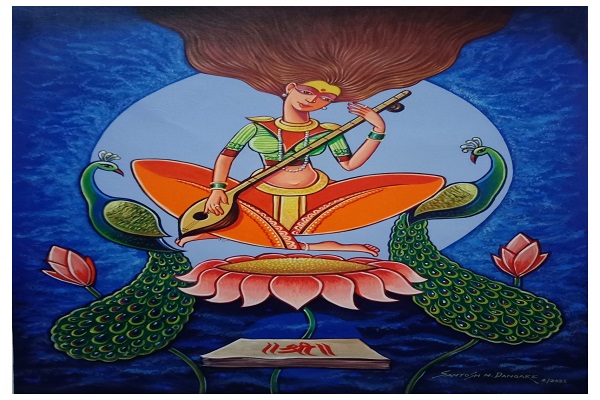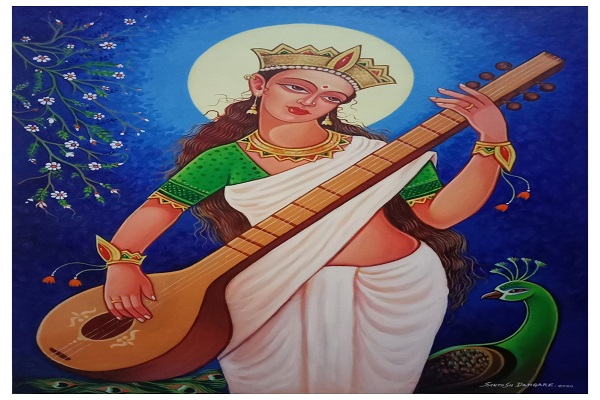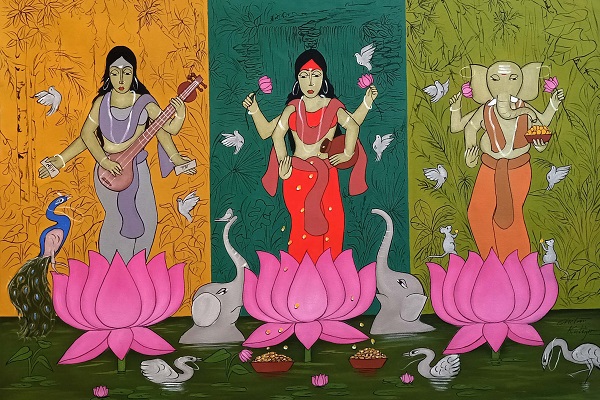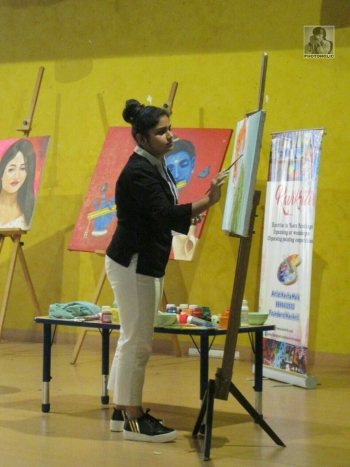
Saraswati, the Hindu goddess of learning, music, and the arts, has long been a representation of creativity and wisdom. Her name is a combination of the Sanskrit terms "Saras," which means "flowing water," and "wati," which means "she who possesses." She is frequently shown as a lovely woman with four arms carrying a book, a rosary, a lute or veena, and a jug of water.
The paintings of Saraswati playing musical instruments and reading literature are among the most important ways that she is shown. These depictions of Saraswati as the patroness of the arts and a source of inspiration for creativity open a portal into the worlds of music and writing. The vivid hues and minute details of Saraswati paintings are a monument to India's creative talent as well as to the country's rich cultural legacy.
Around the years, Saraswati paintings have become incredibly famous, inspiring artists all around the world to create their own depictions of the goddess. In fact, a recent survey found that demand for Saraswati paintings has grown by 40% over the past ten years. These paintings are prized by both art collectors and admirers for their capacity to uplift and induce a feeling of spirituality.
Continue reading to find out more about how Saraswati paintings represent music and literature.
Historical context
Hinduism has always included Saraswati paintings in its culture. Since India has always revered the goddess, Saraswati, several creative movements and cultural influences have influenced how she has been portrayed in paintings.
The first known Saraswati paintings were created in the Kushan Empire in the second century BC. The Ajanta Caves in Maharashtra, India, is a UNESCO World Heritage site, where these paintings were discovered. The paintings include numerous situations from the Buddha's life as well as gods like Saraswati, who were revered during the period by both Buddhists and Hindus.
Saraswati paintings have changed throughout the years, reflecting India's changing religious and cultural landscape. Paintings by Saraswati were influenced by Persian and Islamic art during the Mughal era, which lasted from the 16th through the 18th century, creating a distinctive blend of styles. Traditional Hindu motifs were frequently mixed with complex flower designs and calligraphy in artworks from this era.
With the development of the Bengal School of Art in the 19th and 20th centuries, Saraswati paintings suffered yet another change. This school's artists focused on using vivid colors and strong brushstrokes to produce paintings that were more lively and expressive. As the painters experimented with new methods and aesthetics, the impact of European art could be seen in these works as well.
Saraswati paintings are still a common topic for painters in India and other countries today. The possibilities for developing fresh and original interpretations of the goddess have only increased with the development of digital art. Saraswati paintings, whether they are produced digitally or on canvas, are a tribute to Hinduism's lasting cultural influence.
Depiction of Music in Saraswati Paintings

The paintings of Saraswati are well known for their representations of music; the goddess is frequently seen playing instruments like the veena and flute. The essence of music as a kind of information and its capacity to arouse emotions and stimulate creativity is captured in these paintings.
The veena, a stringed instrument that is said to have been created by the goddess herself, is one of the musical instruments that is frequently seen in Saraswati paintings. The veena is frequently shown in Saraswati's hands as a representation of her mastery of the arts and music. The flute, which stands for the heavenly and sublime character of music, is another common musical instrument in Saraswati paintings.
Beyond their outward look, musical instruments have a deeper symbolic meaning in Saraswati paintings. They stand for the notion that music is a potent vehicle for intellectual and spiritual development in addition to being a kind of entertainment. When performed by Saraswati, music has the ability to invigorate the spirit, spur creativity, and serve as a repository of spiritual wisdom.
Music is frequently shown in Saraswati paintings as a type of wisdom that the goddess imparts to her devotees. For instance, it is thought that the veena symbolizes the three realms of knowledge—the physical, the intellectual, and the spiritual—and the strings signify the many routes to enlightenment.
Saraswati paintings emphasize the value of music and the arts in Indian culture by stressing how they help to foster intellectual and spiritual development. These paintings continue to astonish and inspire with the representation of musical instruments and the goddess Saraswati.
Depiction of Literature in Saraswati Paintings

The paintings of Saraswati also highlight the value of literature by portraying the goddess holding a quill or pen while being surrounded by books. These works of art serve as a reminder of the value of literature as a repository of information and understanding.
Books and writing implements are frequently utilized as symbols in Saraswati paintings to convey the strength of knowledge and the significance of education. The writing implements indicate the value of written language in conserving and conveying information, while the volumes stand for the collected wisdom of the centuries.
The image of the goddess reading a book while seated on a lotus flower is one of the most well-known Saraswati paintings symbolizing literacy. This illustration represents the ability of books to stimulate the intellect and raise the spirit. In some paintings, the goddess is surrounded by books, scrolls, and other writing implements, highlighting the value of knowledge and learning.
Literature is seen in Saraswati paintings as a type of knowledge necessary for both intellectual and spiritual development. The goddess Saraswati is frequently portrayed as the embodiment of this wisdom, and seeing her evokes both imaginative flair and intellectual pique.
The significance of literacy and education in Indian culture is emphasized in Saraswati paintings by the representation of books and writing implements. They serve as a reminder that the joy of learning and the quest of information are necessary for development on both a personal and social level. At the end of the day, Saraswati paintings still serve as a source of inspiration and a celebration of the transformational power of books.
Fusion of Music and Literature in Saraswati Paintings

In many Saraswati paintings, the goddess is seen singing or playing a musical instrument while surrounded by books and writing instruments. These paintings demonstrate the close relationship and shared significance of music and literature in Indian culture.
The picture of the goddess playing the veena while seated on a lotus flower and surrounded by books and scrolls is one instance of a Saraswati artwork that illustrates the blending of music and literacy. The combination of these two art forms is perfectly captured in this picture, which highlights the ability of music to arouse emotion and spur creativity while simultaneously highlighting the value of books in the transmission of information and wisdom.
The combination of music and literature in Saraswati paintings is noteworthy because it illustrates the concept that these two art forms are complementary rather than competing with one another. Together, music and literature may be potent force for intellectual and cultural advancement since they both have the ability to uplift the spirit.
Additionally, the use of music and literature in Saraswati's paintings emphasizes the value of interdisciplinary study and the connection between many branches of knowledge. It encourages people to examine the links between what may seem like unrelated fields of study and to pursue a variety of interests.
The beauty and strength of music and literature, as well as their capacity to alter and inspire, are celebrated in this way via Saraswati paintings. They encourage us to accept the blending of these two artistic disciplines and to recognize how diverse and linked knowledge and culture are.
Contemporary Saraswati Paintings
The significance of music and literature in Indian culture is still portrayed in contemporary Saraswati paintings, but they also reflect the times by utilizing fresh styles and methods.
A range of techniques, including digital art, acrylics, and mixed media, may be used to produce modern Saraswati paintings, which frequently have vivid and striking hues. These paintings typically show the goddess surrounded by musical gear, such as guitars and keyboards, which reflects how music has changed in contemporary Indian culture.
The use of calligraphy and typography to create beautiful designs with quotations from literary works is one instance of how modern Saraswati paintings reflect literature. These works of art demonstrate the elegance of the written word as well as the ability of language to move and inspire.
By infusing fresh ideas and aesthetics, modern painters have updated Saraswati paintings to suit contemporary culture. For instance, some artwork may depict the goddess surrounded by scientific or technological apparatus, highlighting the significance of STEM education in the modern world. Other works of art could examine the idea of cultural fusion and global connectivity.
These modern Saraswati paintings are a reflection of how Indian civilization is evolving and how it is still dedicated to the pursuit of knowledge and creativity. They emphasize the diversity and complexity of Indian culture while simultaneously emphasizing its fluidity and continual change.
In this way, modern Saraswati paintings continue to motivate and inspire people to embrace the synthesis of literature and music and to investigate the relationships between many branches of knowledge in a world that is changing quickly.
Recap

The centrality of music and literature in Indian culture is depicted in Saraswati paintings, which also highlight how current art is always growing. We are reminded of the goddess Saraswati's timeless significance and her significant position as a symbol of wisdom and creativity via these paintings.
Additionally, IndianArtIdeas is a fantastic resource for collectors and art aficionados to learn about and appreciate the beauty of Indian art. They also have a vast selection of Maa Durga paintings, another important and potent goddess in Hindu mythology, in addition to other interesting pieces by well-known painters. We can contribute to the preservation and celebration of India's rich cultural history for future generations by encouraging and supporting Indian Art Ideas.





















